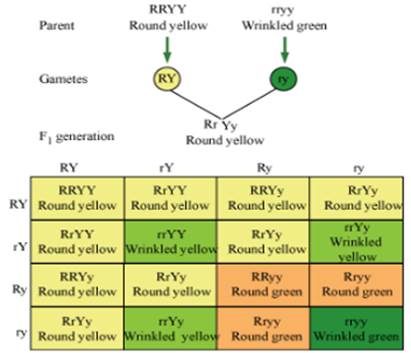Explain Mendel’s experiment with peas on inheritance of traits considering two visible contrasting characters.
Mendel crossed a pea plant that was homozygous and prevailing for round (RR), yellow (YY) seeds with a pea plant that was homozygous and latent for wrinkled (rr), green (yy) seeds, spoke to by the accompanying documentation:
RRYY x rryy
Living beings in this underlying cross are known as the parental, or P age. The offsprings of the RRYY x rryy cross, which is known as the F1 age, were all heterozygous plants with round, yellow seeds and the genotype RrYy.
Next, Mendel crossed two plants from the F1 age. This progression is the dihybrid cross, and it is spoken to as:
RrYy x RrYy
Mendel observed that the F2 descendants of his dihybrid cross had a 9:3:3:1 proportion and created nine plants with round, yellow seeds, three plants with round, green seeds, three plants with wrinkled, yellow seeds and one plant with wrinkled, green seeds. From his analysis, Mendel watched that the sets of attributes in the parental age arranged autonomously from each other, starting with one age then onto the next.

Dihybrid cross